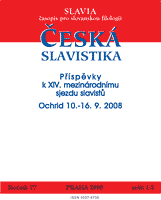Jak rozumíme kategorii gramatického rodu? Kdy je Češka Čech?
How Do We Understand the Category of Gender? When is a Czech woman (Češka) a Czech man (Čech)?
Author(s): Světla ČmejrkováSubject(s): Language and Literature Studies
Published by: AV ČR - Akademie věd České republiky - Slovanský ústav and Euroslavica
Summary/Abstract: We are born into a linguistic community whose language we learn as infants, inheriting the categories it uses and perceiving the distinctions it makes. Should speakers of Slavic languages rely on their native linguistic competence and learned discursive practices? Should they reconsider the interpretation that masculine forms are unmarked? The present paper focuses on Czech and discusses the marked (male) and unmarked (generic) reading of masculine forms in various contexts. It shows that new discourse practices may shift masculine forms from the gender-indefinite to the gender-definite pole of interpretation: in some contexts, it appears that masculine forms are interpreted in a more gender-specific meaning than their unmarked, inclusive meaning would predict. This paper aims to explain why the potential change in linguistic awareness is worthy of theoretical attention.
Journal: Slavia - časopis pro slovanskou filologii
- Issue Year: LXXVII/2008
- Issue No: 1+3
- Page Range: 41-54
- Page Count: 14
- Language: Czech

